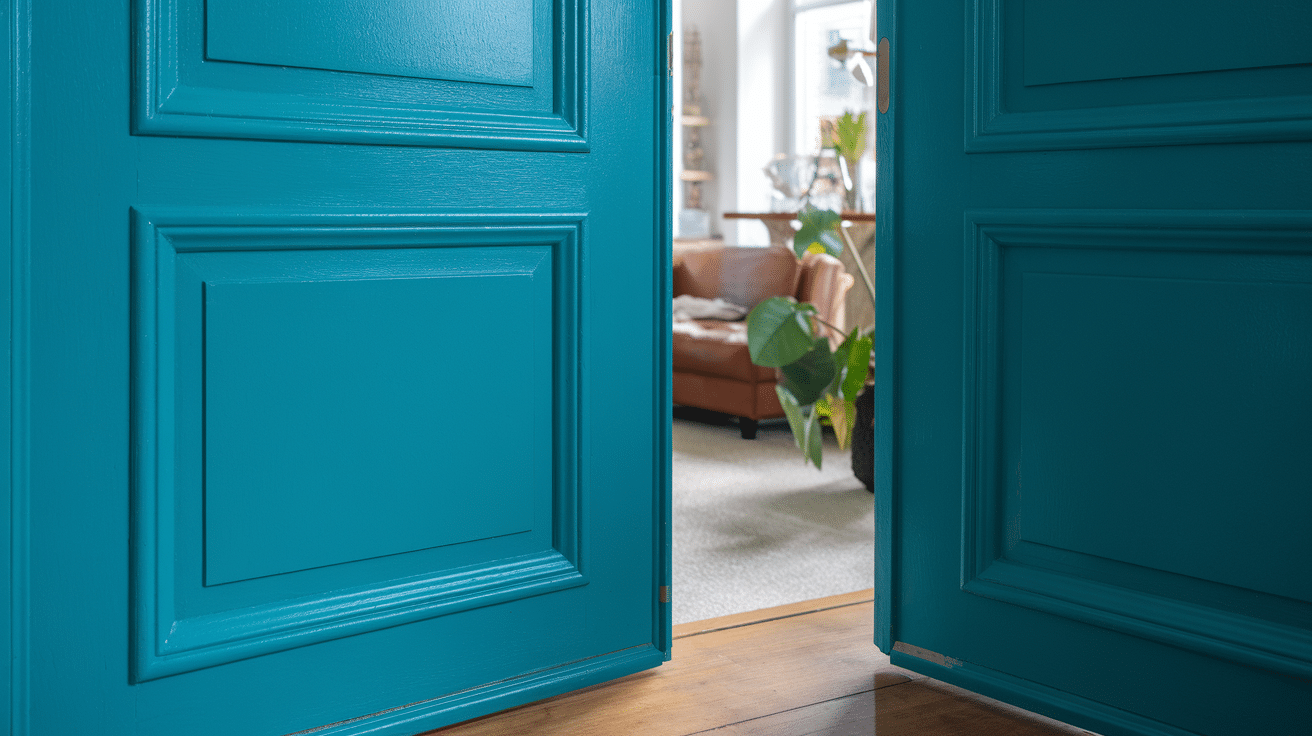Ever noticed how a freshly painted door can make an entire room feel new again?
Your doors take a beating—from fingerprints and scuffs to weather and temperature changes.
They’re opened and closed countless times each day. Yet they’re often the last things we think about painting.
Choosing the right paint for your doors isn’t just about picking a pretty color. It’s about finding something that can stand up to daily life while looking good for years.
Whether you’re refreshing interior doors that have seen better days or tackling that front door that faces the elements, the paint you choose matters more than you might think.
Let’s talk about what really works for doors—from finishes that hide fingerprints to formulas that stand up to whatever life throws their way.
Best Paint Types for Interior Doors
Choosing the right paint type for your interior doors ensures durability, a smooth finish, and easy maintenance, depending on your home’s needs and lifestyle.
Acrylic Latex Paint
Water-based and highly versatile, acrylic latex paint is a top choice for interior doors due to its ease of application and quick drying time.
It has low VOCs, making it a safer option for indoor use with minimal odor. This paint resists cracking and peeling over time, ensuring a long-lasting finish.
Additionally, it cleans up easily with just soap and water, making it ideal for homes with children or pets.
However, while it offers good durability, it may not be as resistant to heavy wear and tear as oil-based options.
Oil-Based Paint
Known for its rich, smooth finish, oil-based paint provides a hard, durable surface that withstands frequent use.
It is highly resistant to scuffs, stains, and moisture, making it a great choice for doors in high-traffic areas or humid environments like bathrooms and kitchens.
Although oil-based paint takes longer to dry and emits stronger fumes, its durability and elegant finish make it a preferred option for a polished, professional look.
Keep in mind that cleanup requires mineral spirits or paint thinner, and some states have restrictions on its use due to environmental concerns.
Best Interior Door Paint Ideas
Paint color can change the mood of your home. Depending on your goal—whether to make your doors blend in or stand out as a design feature—the right hue can improve visual flow and bring a polished, finished look to your space
When selecting an interior door color, think about trim contrast, wall tones, lighting conditions, and how much visual impact you want the doors to have.
Here are 11 stylish interior door color ideas:
1. Soft White
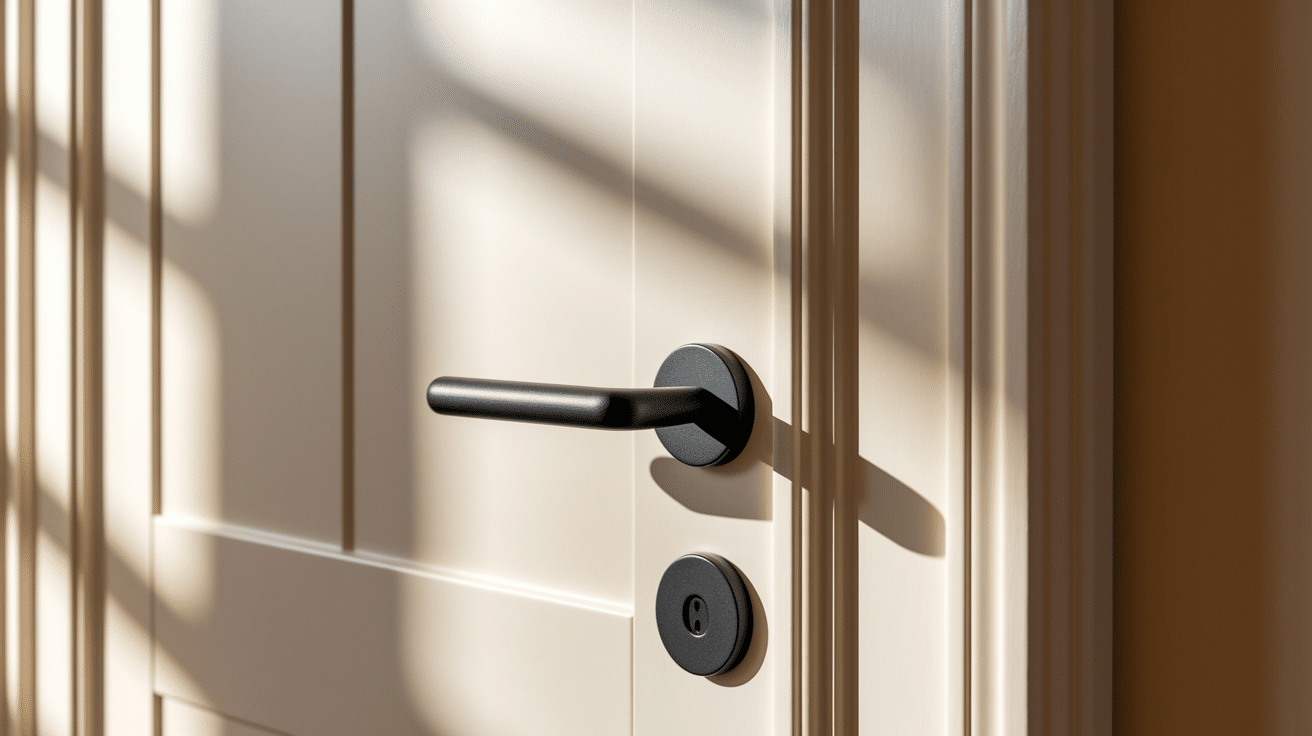
Soft white doors create a clean appeal that works well in both classic and modern interiors. This hue reflects light beautifully, helping to open up tight spaces or dim corners.
It’s the go-to choice for minimalist or coastal homes seeking brightness and simplicity. Soft white brings a feeling of purity and calm without appearing sterile. It can be used throughout the home for a cohesive and airy effect.
For the best results, pair soft white doors with crisp white walls or pale neutrals for a seamless, spacious feel. It also works beautifully against soft pastels for a delicate, inviting palette.
Benjamin Moore: “Chantilly Lace OC-65” – A bright, clean white with minimal undertone
Sherwin-Williams: “Alabaster SW 7008” – A warm, creamy white perfect for cozy interiors
2. Charcoal Gray
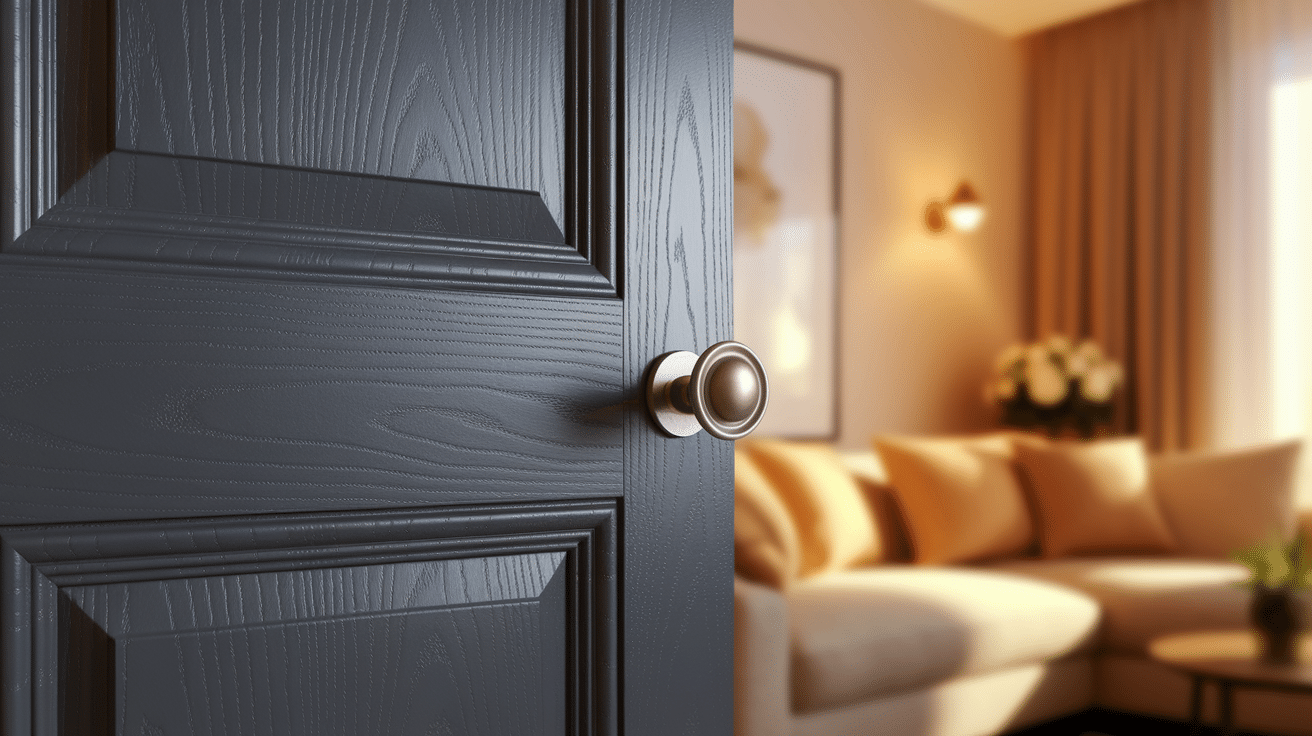
Charcoal gray doors introduce a moody appearance without being too overpowering. This deep neutral adds visual weight, making it ideal for balancing open or minimal spaces.
It suits modern and industrial homes, as well as traditional ones wanting a contemporary touch.
Charcoal gray is less harsh than black but still provides strong contrast. Its versatility makes it a designer favorite for a polished, grounded look.
For the best results, pair charcoal gray doors with light gray or white walls for contrast, or with natural textures like stone and wood for a cozy, layered aesthetic.
Benjamin Moore: “Kendall Charcoal HC-166” – A deep, rich gray with warm undertones
Sherwin-Williams: “Peppercorn SW 7674” – A dramatic, saturated charcoal gray
3. Matte Black
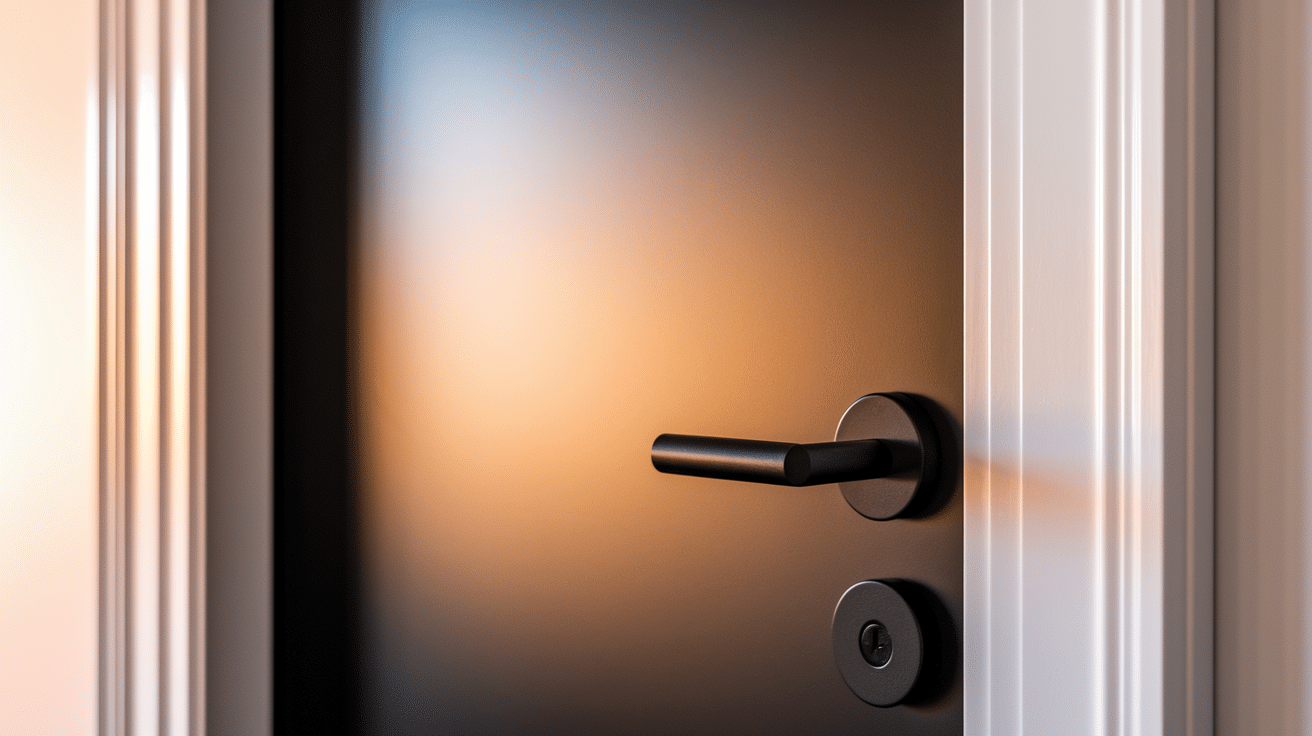
Matte black doors are a bold statement in any room, bringing sleek drama and modern look. The non-reflective finish offers a more understated look than glossy black, adding texture and depth.
Matte black works well in high-contrast schemes and elevates even the simplest design. It’s an excellent choice for contemporary, Scandinavian, or urban-inspired interiors. The look is edgy, perfect for a curated space.
For the best results, pair matte black doors with white or pale gray walls and warm metallic accents like brass or copper for balance.
Benjamin Moore: “Black Panther 2125-10” – A deep, matte black with subtle softness
Sherwin-Williams: “Tricorn Black SW 6258” – A rich, pure black ideal for a matte finish
4. Dusty Blue
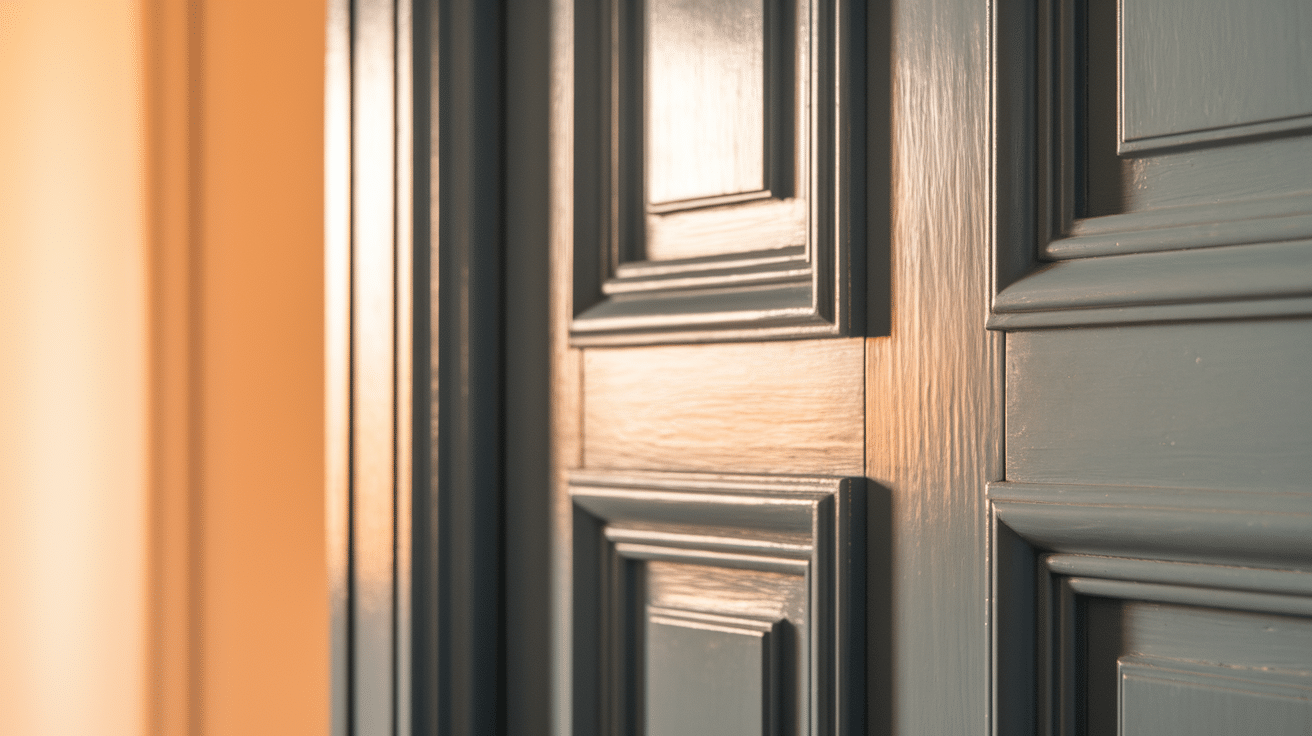
Dusty blue doors bring a calm, serene atmosphere to a space, evoking sky and sea tones. This color works particularly well in bedrooms, bathrooms, or home offices where tranquillity is desired.
It has a vintage charm that also feels current, especially when paired with matte finishes. Dusty blue softens modern rooms and adds a pop of color without being overpowering. It complements both light and dark color schemes beautifully.
For the best results, pair dusty blue doors with crisp whites or warm taupes for a coastal or cottage-style vibe.
Benjamin Moore: “Boothbay Gray HC 165” – A subtle blue-grey with a refined finish
Sherwin-Williams: “Misty SW 6232” – A soft, smoky blue-grey that soothes the senses
5. Sage Green
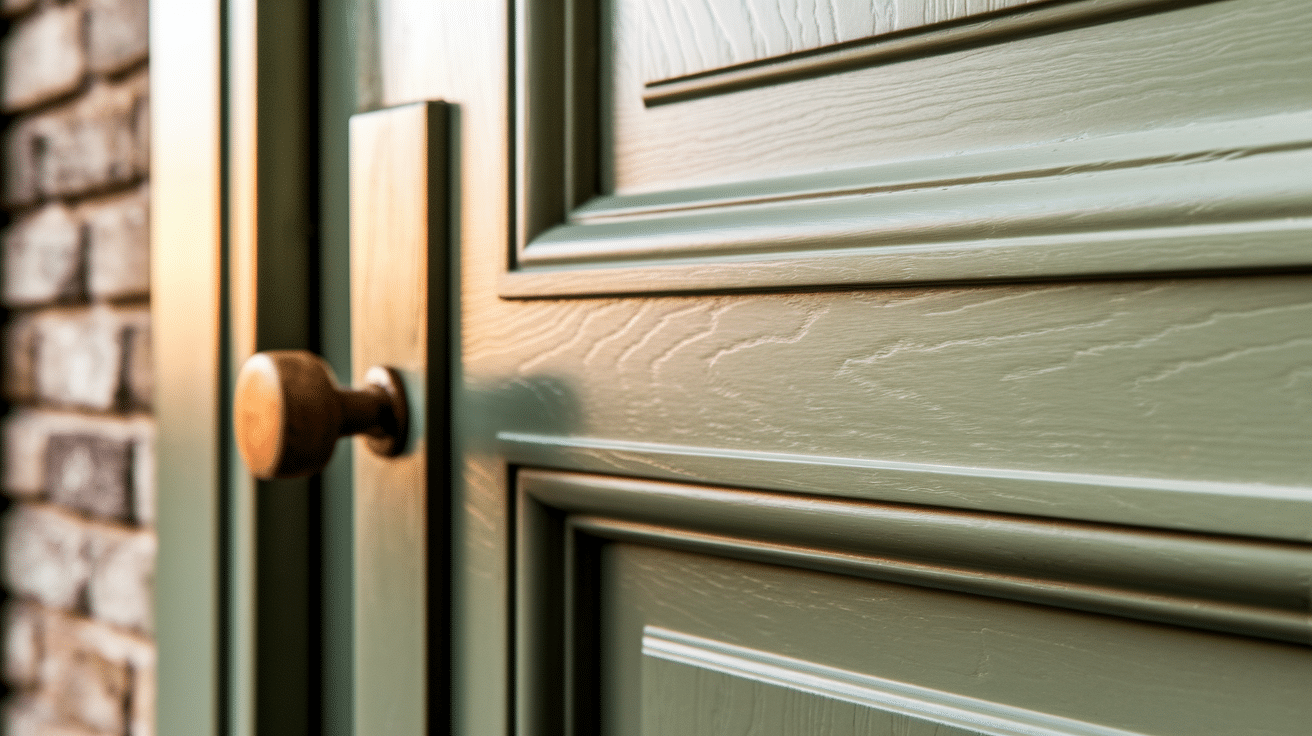
Sage green doors offer a fresh, earthy touch that brings the outdoors in. This muted green hue is both calming and grounded, ideal for entryways, kitchens, and bathrooms.
It balances warmth and coolness, making it a flexible choice across styles from farmhouse to mid-century. Sage evokes a natural look without being too bold. It creates an inviting atmosphere that pairs beautifully with natural materials.
For the best results, pair sage green doors with warm wood tones, creamy whites, or terracotta accents for a nature-inspired palette.
Benjamin Moore: “Saybrook Sage HC 114” – A soft, classic sage with warm undertones
Sherwin-Williams: “Clary Sage SW 6178” – An earthy, muted green perfect for cozy interiors
6. Greige (Gray-Beige)
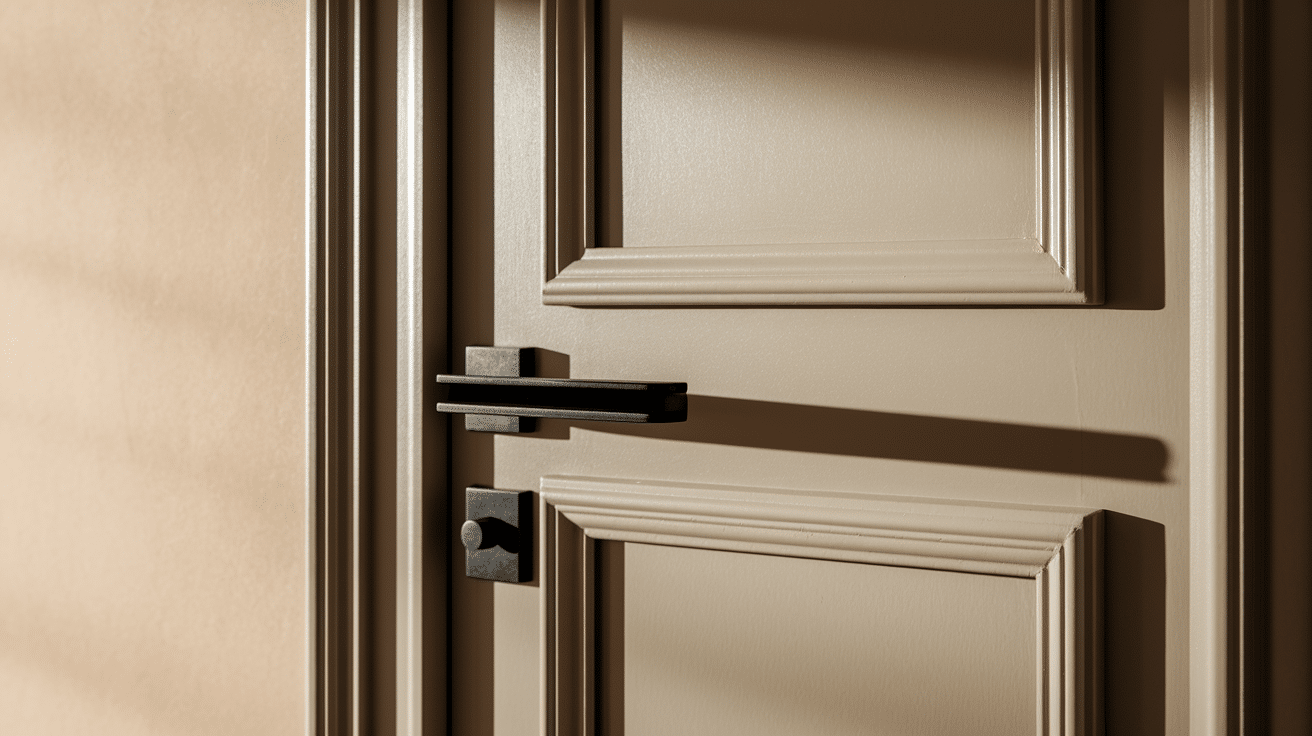
Greige doors are the ultimate neutral—blending the grey with the warmth of beige. They adapt easily to warm or cool palettes and give interiors an upscale appeal.
Greige is subtle offering more depth than plain white or grey. It’s a great backdrop for layered décor or minimal styling. This color suits transitional, modern farmhouse, or Scandinavian interiors.
For the best results, pair greige doors with soft whites, deep charcoals, or blush tones for a balanced, harmonious look.
Benjamin Moore: “Revere Pewter HC 172” – A light grey beige that works in any light
Sherwin-Williams: “Agreeable Gray 7029” – A bestselling warm greige with universal appeal
7. Muted Navy
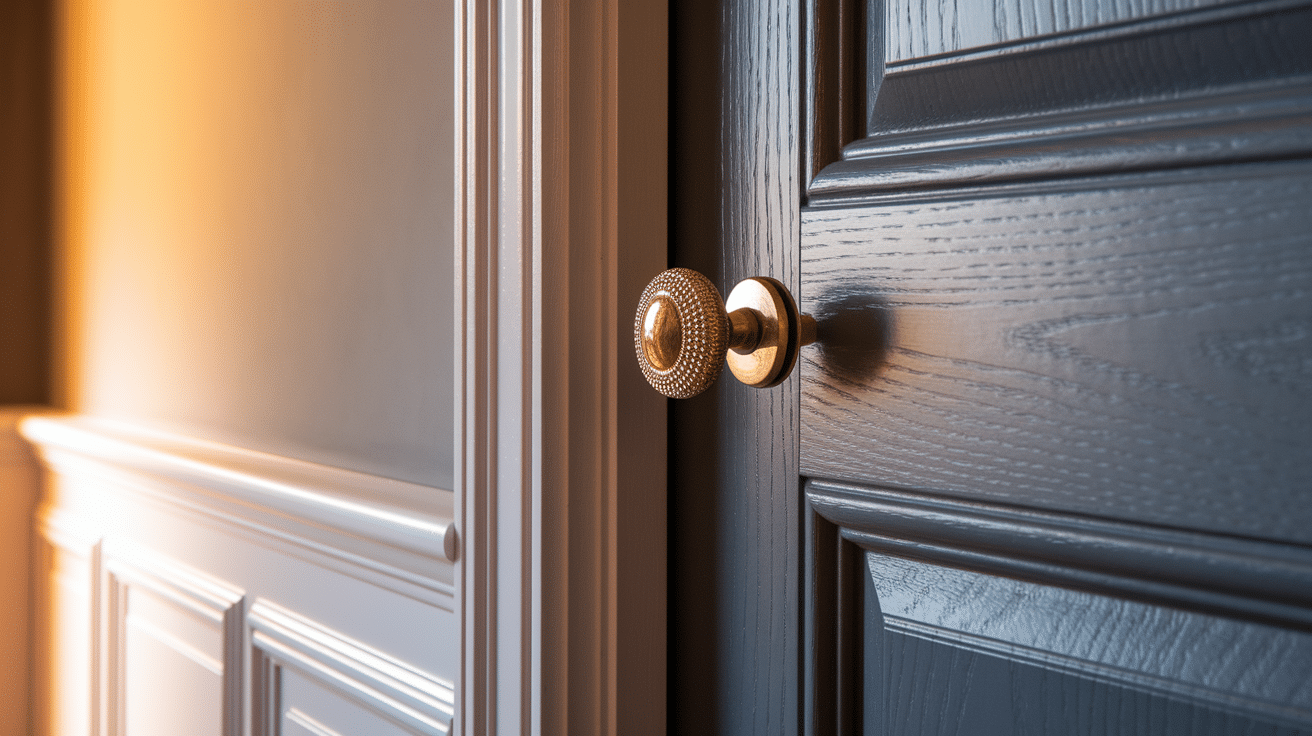
Muted navy doors deliver a sense of richness and refinement without being too dark. This softened version of navy is bold enough to stand out but still restrained. It adds classic depth to entryways, dining rooms, or offices.
Muted navy feels versatile, elevating transitional and coastal-inspired interiors. It complements golds, whites, and wood finishes beautifully.
For the best results, pair muted navy doors with warm white walls and brass hardware for a polished, upscale finish.
Benjamin Moore: “Hale Navy HC 154” – A designer-favorite navy with modern appeal
Sherwin-Williams: “Naval SW 6244” – A deep, balanced navy with a calm presence
8. Warm Taupe
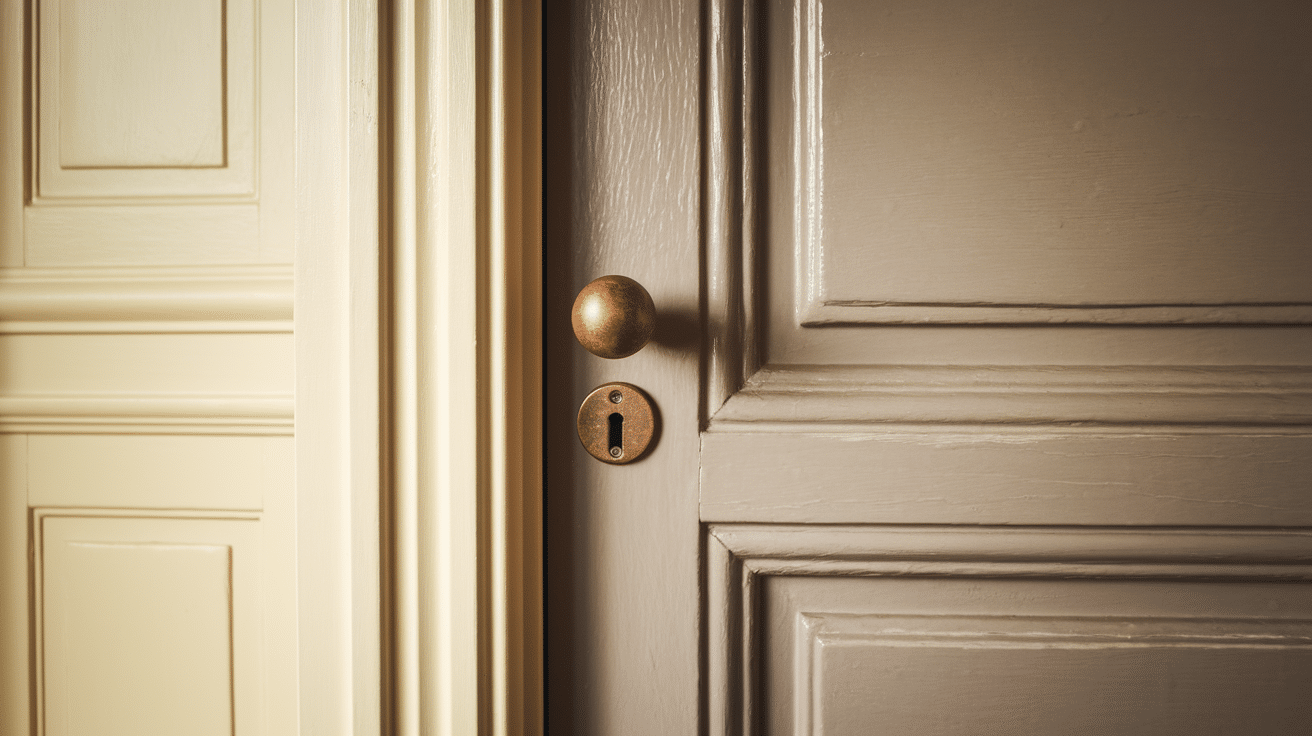
Warm taupe doors bring a soft cosiness that feels both neutral and grounded. With its mix of brown and grey undertones, warm taupe complements natural textures and layered interiors.
It feels approachable and homey, perfect for traditional or bohemian styles. Taupe doesn’t demand attention but subtly improves the atmosphere. It’s an inviting color that looks gentle across seasons.
For the best results, pair warm taupe doors with creamy whites, soft greens, or burnt oranges for a cohesive, earthy scheme.
Benjamin Moore: “Shaker Beige HC 45” – A warm, versatile neutral with sandy undertones
Sherwin-Williams: “Tony Taupe SW 7038” – A grounded, medium taupe that pairs well with wood
9. Soft Blush
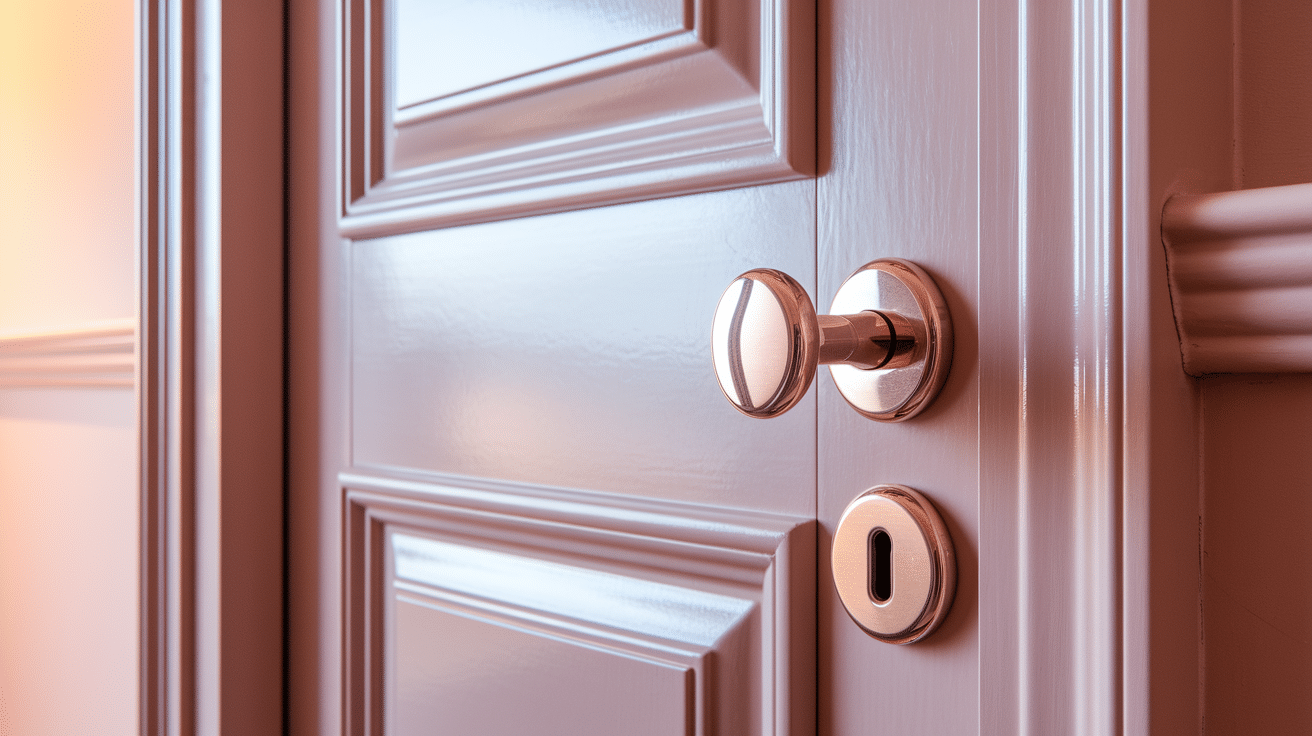
Soft blush doors bring warmth and a romantic touch without overwhelming the room. This pale pink hue works well in nurseries, powder rooms, or anywhere a gentle, inviting mood is desired.
It adds personality while still reading neutral in the right light. Soft blush can create a calming contrast to deeper colors or pair softly with creams. It’s an unexpected choice that flatters a variety of spaces.
For the best results, pair soft blush doors with warm whites, brass accents, or even charcoal grays for contrast.
Benjamin Moore: “First Light 2102-70” – A modern, soft pink with a breath of fresh air
Sherwin-Williams: “In the Pink SW 6583” – A subtle pastel that feels fresh and light
10. Olive Green
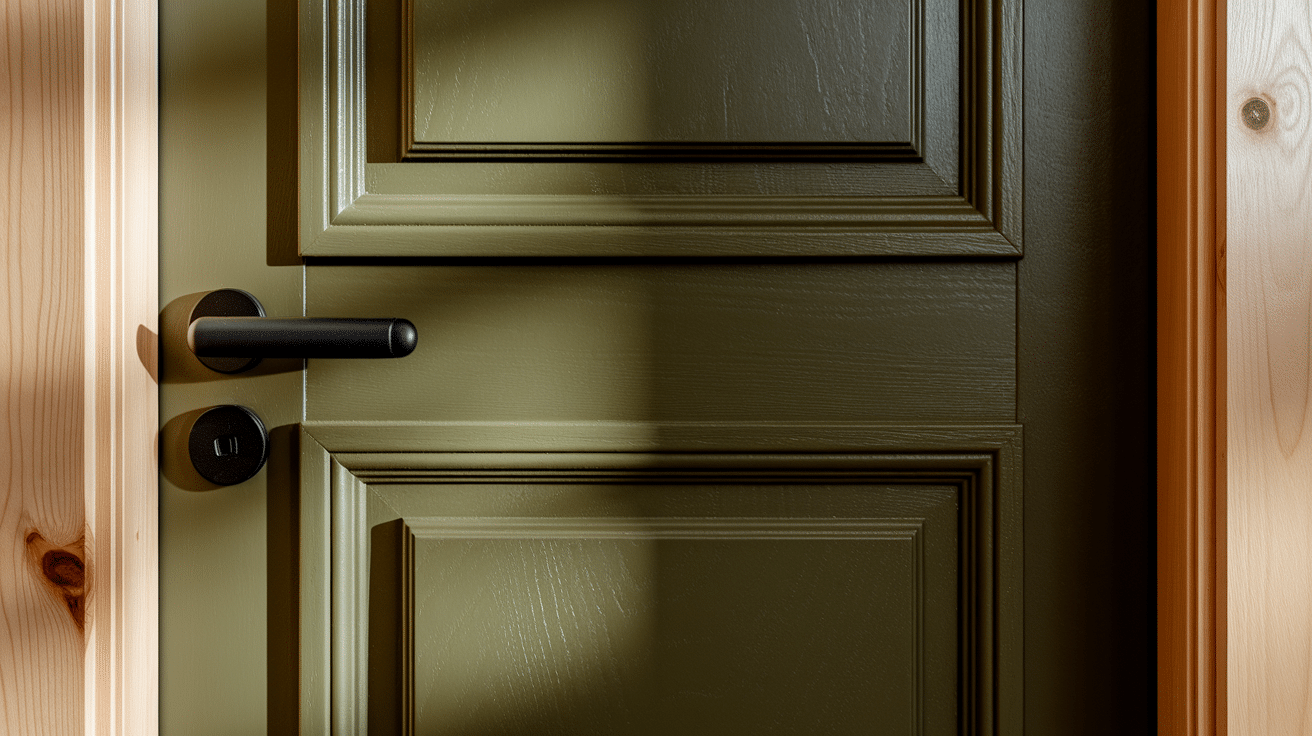
Olive green doors strike the perfect balance between bold and earthy, adding character and style to any room. This hue brings a vintage-meets-modern vibe and works well in rustic or mid-century homes.
Olive green creates a cozy, lived-in feel and complements leather, wood, and neutral tones. It’s grounded yet expressive, great for entry doors or interior statements. This color adds just the right amount of color without going too bright.
For the best results, pair olive green doors with cream walls, tan leathers, or brass accents for a natural, retro-inspired look.
Benjamin Moore: “Vintage Vogue 462” – A deep olive green with modern charm
Sherwin-Williams: “Ripe Olive SW 6209” – A deep, bold olive that makes a stylish statement
Best Exterior Door Paint Ideas
Your exterior door creates a strong first impression. Whether you want curb appeal, architectural harmony, or a pop of personality, the right color can make a lasting impact.
Before choosing a color, factor in your siding, roofing, landscape, and the amount of sunlight your entry receives.
Here are 11 standout exterior door color ideas:
11. Classic Red
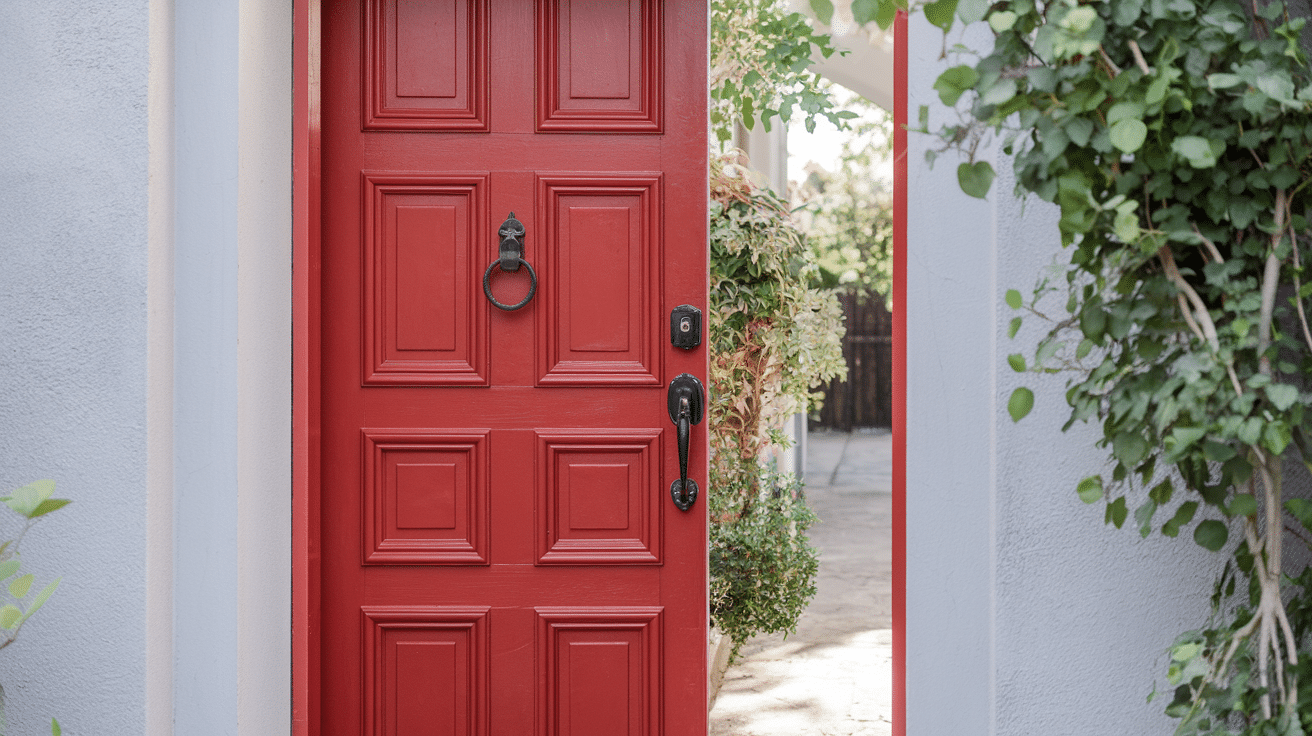
Classic red doors are vibrant and inviting, making a bold statement that draws attention. This color has long been associated with warmth and hospitality, often seen in traditional and colonial-style homes.
It adds a sense of energy and can serve as a focal point in exterior design. Red doors can also symbolize good luck and prosperity in various cultures. Their appeal ensures they remain a popular choice across different architectural styles.
For the best results, pair classic red doors with neutral siding colors like white, gray, or beige to allow the red to stand out. Complementary landscaping with green foliage can further amplify the door’s prominence.
Benjamin Moore: “Caliente AF-290” – A vibrant, rich red that commands attention.
Sherwin-Williams: “Real Red SW 6868” – A true red that adds a lively touch.
12. Midnight Blue
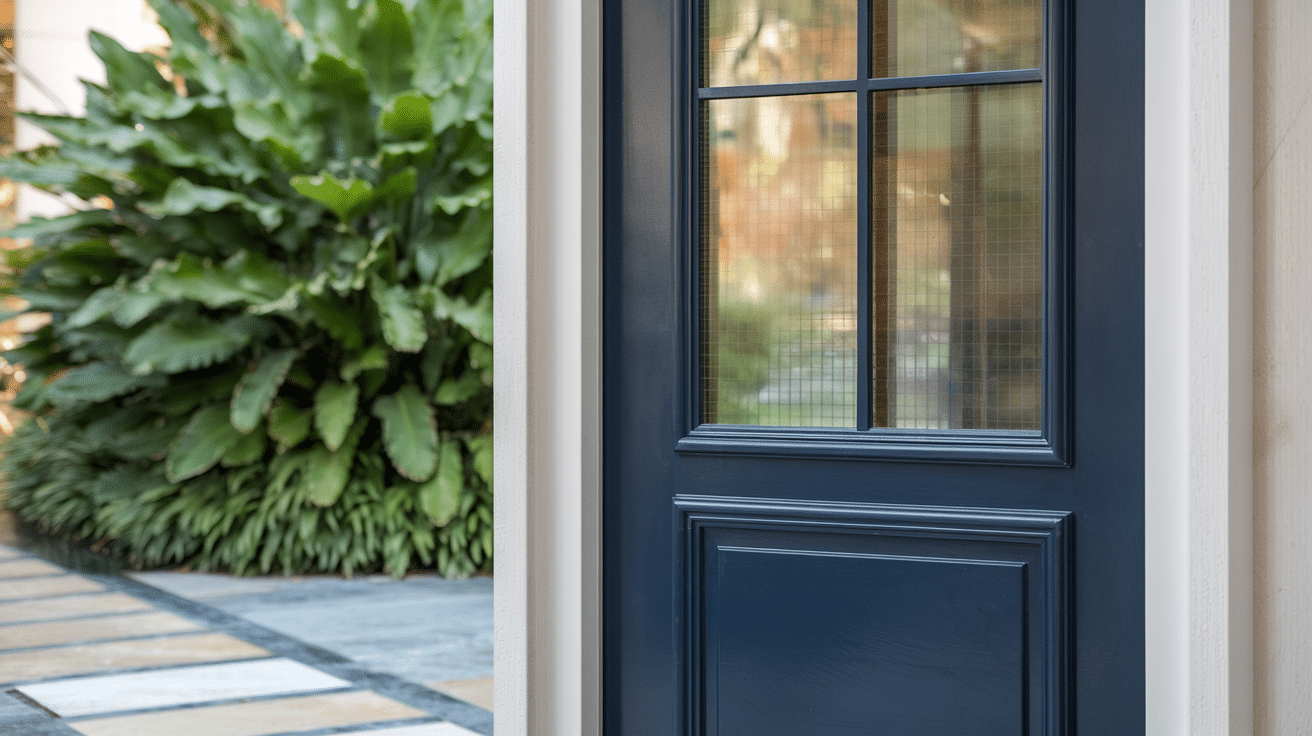
Midnight blue doors offer a deep, calming presence that exudes confidence. This shade provides a strong contrast against lighter exteriors, making it a standout feature.
It’s versatile enough to complement both modern and traditional architectural styles. The depth of midnight blue can evoke feelings of stability and trust. It’s an excellent choice for those looking to add a touch of boldness without overwhelming brightness.
For the best results, pair midnight blue doors with light-colored exteriors, such as whites or creams, to create a striking contrast. Accents in silver or brushed nickel can amplify the door’s cool tones.
Benjamin Moore: “Blue 2066-10” – A classic navy with a balanced depth.
Sherwin-Williams: “Azure Tide SW 9684” – A deep navy that was Color of the Year in 2020.
13. Forest Green
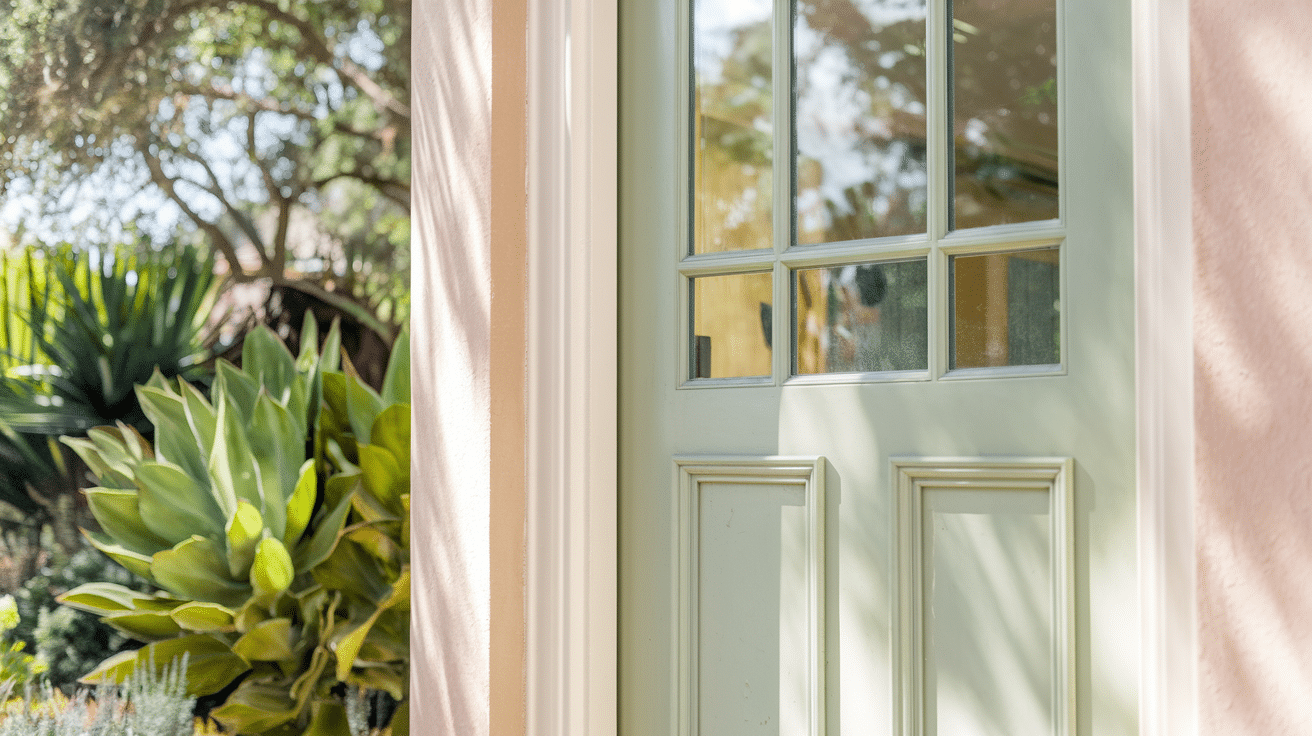
Forest green doors bring a touch of nature to your home’s exterior, offering a grounded and serene appearance. This color is reminiscent of lush woodlands and can blend seamlessly with natural surroundings.
It’s particularly suited for homes in wooded areas or those with rustic designs. Forest green can also convey a sense of tradition and stability. Its earthy tone makes it a versatile choice for various home styles.
For the best results, pair forest green doors with natural materials like stone or wood siding. Neutral trim colors, such as beige or taupe, can complement the green without competing with it.
Benjamin Moore: “Black Forest Green HC 187” – A deep green with black undertones.
Sherwin-Williams: “Rookwood Dark Green SW 2816“– A historic green with depth.
14. Matte Black
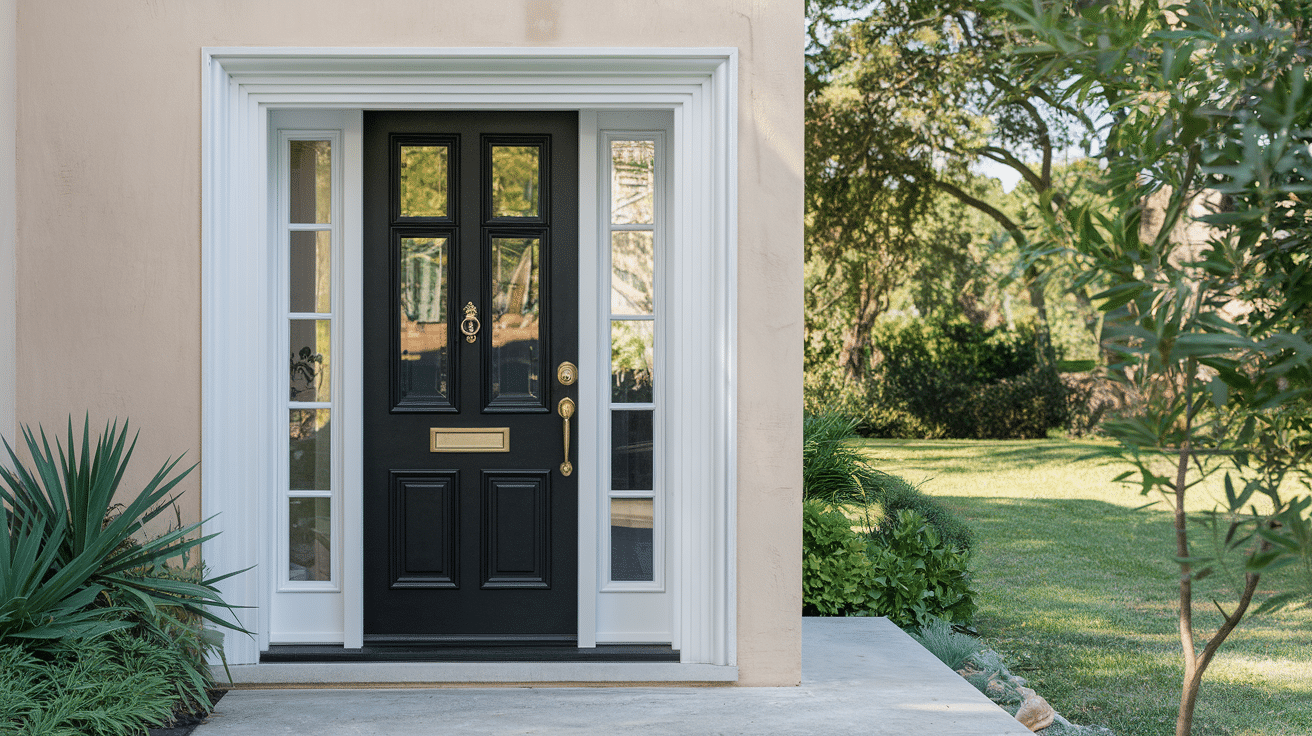
Matte black doors offer a sleek, modern look that adds a touch of modern look. The non-reflective finish provides a subtle look, making it a popular choice for contemporary homes.
Black doors can create a strong visual contrast, especially against lighter exteriors. They also have the advantage of hiding minor scuffs and fingerprints better than glossy finishes. Matte black is a versatile color that pairs well with various materials and styles.
For the best results, pair matte black doors with white or light gray exteriors to create a striking contrast. Metallic hardware in gold or brass can add warmth and interest.
Benjamin Moore: “Black Beauty 2128-10” – A rich black that adds depth.
Sherwin-Williams: “Tricorn Black SW 6258 “– A true black that’s bold and neutral.
15. Bright Yellow
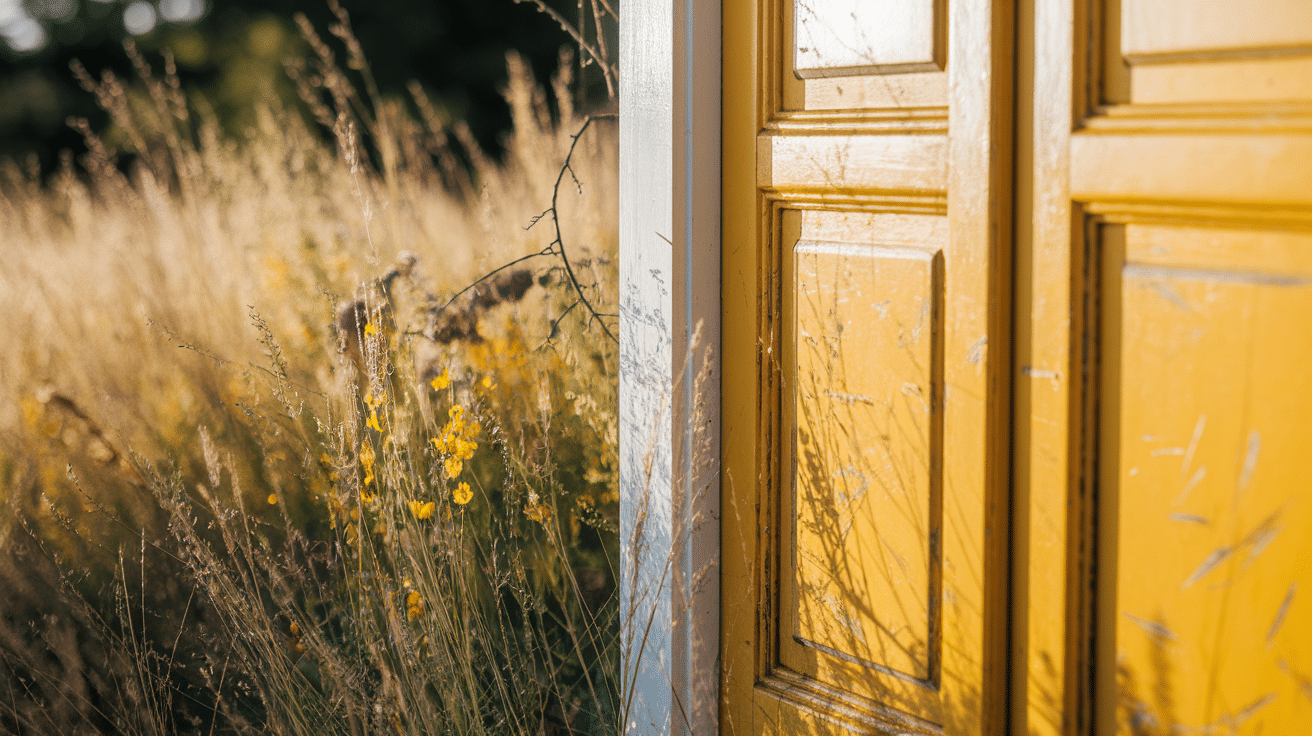
Bright yellow doors infuse a sense of cheerfulness and energy into your home’s exterior. This vibrant color can make your entrance stand out and feel welcoming. Yellow is often associated with happiness and optimism, making it an excellent choice for creating a positive first impression.
It’s particularly effective in areas with frequent overcast weather, as it can brighten up the facade. Bright yellow works well with a variety of architectural styles, from modern to cottage.
For the best results, pair bright yellow doors with neutral exteriors like gray, white, or navy blue. Accents in black or dark gray can provide a grounding effect.
Benjamin Moore: “Sunburst 2023-40“– A sunny yellow that adds warmth.
Sherwin-Williams: “Lemon Twist SW 6909“– A cheerful yellow that pops.
Common Mistakes to Avoid
Before painting your door, make sure to avoid these mistakes for the best result and longevity.
- Skipping Primer: Not applying primer before painting can lead to poor adhesion and a less durable finish.
- Using the Wrong Paint: Choosing paint that isn’t suitable for the door’s material can cause uneven coverage.
- Not Sanding the Surface: Failing to sand the door before painting can result in a poor paint adhesion.
- Overloading the Brush or Roller: Applying too much paint at once can cause drips and an uneven finish.
- Rushing Drying Time: Not allowing adequate drying time between coats can lead to smudging or streaks.
- Painting in Poor Weather: Painting exterior doors in high humidity can cause the paint to dry improperly.
- Skipping Proper Surface Cleaning: Not cleaning the door thoroughly before painting can trap dirt and oils, leading to a poor paint job.
- Not Using the Right Tools: Using low-quality brushes or rollers can leave streaks, uneven texture, or bristle marks on the door.
The Right Paint Makes All the Difference
When it comes to door paint, there’s no one-size-fits-all answer. The best choice depends on your doors, your home, and your life.
Interior doors in high-traffic areas need durability above all. Exterior doors need to stand up to whatever weather throws their way.
Quality matters more than most people realize. Better paints mean fewer coats, longer-lasting finishes, and colors that stay true over time.
Test your colors in different lights before committing. What looks perfect in the store might feel very different once it’s on your door at home.
The right paint turns even the most overlooked doors into something special—not just by how they look, but by how well they hold up through the years.

